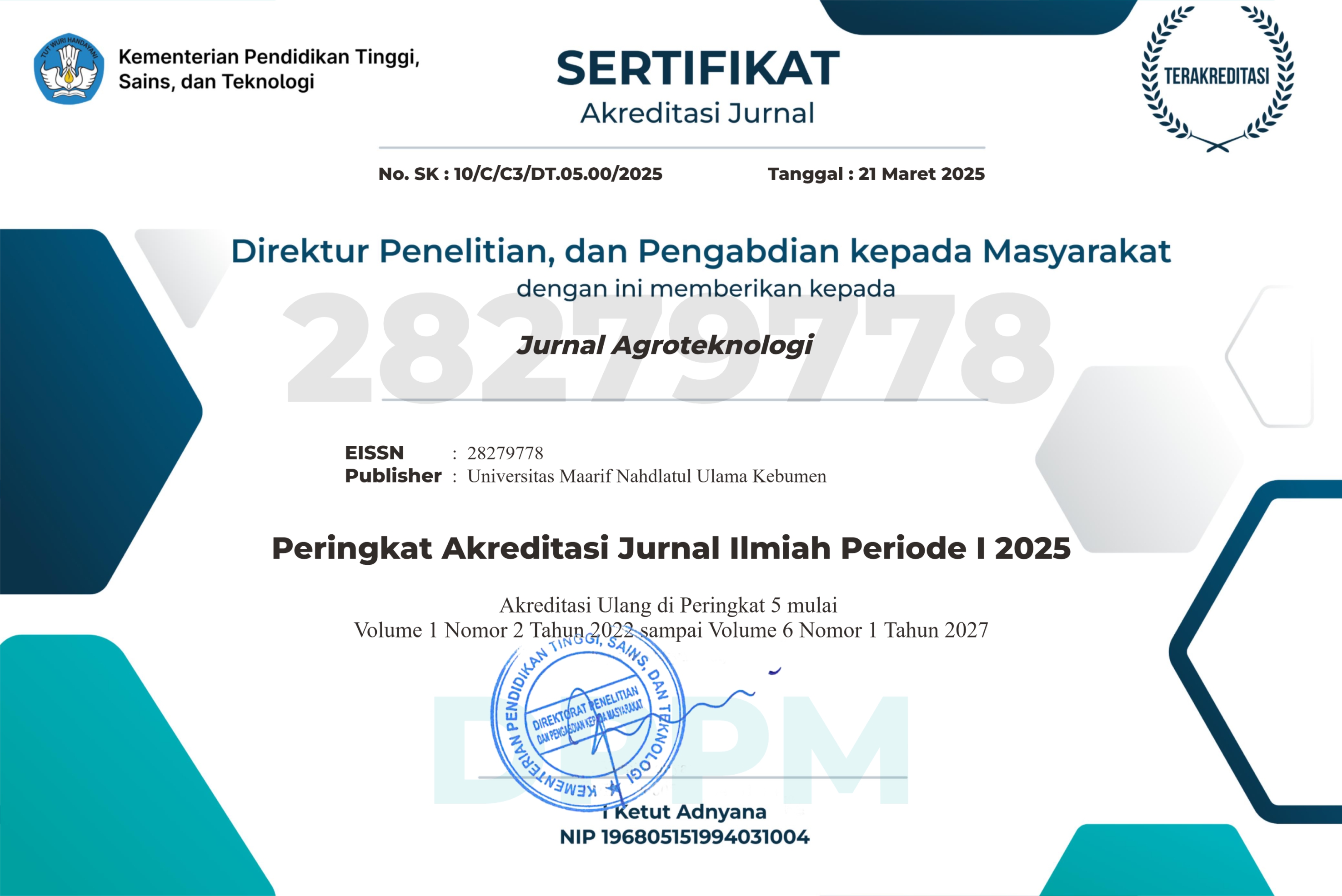Optimalisasi Dosis Pupuk Biourine Sapi untuk Meningkatkan Pertumbuhan dan Produksi Pakcoy (Brassica rapa L.)
DOI:
https://doi.org/10.53863/agronu.v4i02.1763Keywords:
Cow biourine, Pak choi, Liquid organic fertilizerAbstract
Biourine fertilizer is a liquid organic fertilizer derived from fermented livestock urine with the help of decomposer materials such as EM4 or MOL. Although potential as a source of nutrients, the use of biourine does not yet have the right dose standards and stable quality. This study aims to determine the effect of various doses of cow biourine fertilizer on the growth and production of pak choy plants, as well as to determine the optimum dose that gives the best results. The study was conducted experimentally in a screen house using polybag media, with a non-factorial completely randomized design (CRD) consisting of five dose treatments: P0 (0 ml/L), P1 (10 ml/L), P2 (20 ml/L), P3 (30 ml/L), and P4 (40 ml/L). Each treatment was repeated five times, resulting in 25 experimental units. The parameters observed included plant height, number of leaves, leaf length, leaf width, and wet compost weight. Data were analyzed using ANOVA at a 5% significance level and a 5% BNJ further test to see the differences between treatments. The results showed that the provision of cow biourine fertilizer had a significant effect on the growth and yield of pak choi. Treatment P2 (20 ml/L) gave the best results in most parameters including plant height, leaf length including the highest wet stalk weight of 77.40 grams which was significantly different compared to other treatments. Thus, a dose of 20 ml/L cow biourine can be recommended as the optimum dose for the growth and yield of pak choi plants
References
Abdullatip, A., Anwar, M., Sarlan, M., & Prasetyowati, R. E. (2025). Farmers’ Responses to Farmer Field Schools (FFS) on Integrated Crop Management: A Case Study in East Lombok, Indonesia. Journal of Agricultural Socio-Economics (JASE), 6(1), 30–39. https://doi.org/10.33474/jase.v6i1.23894
Aniket, K., Shelke, M. E., Athawale, S., Bansod, S., & Dadmal, T. L. (2024). Cow Urine as Emerging Biopesticides : A Mini-Review. International Journal of Scientific Research in Science and Technology, 11(5), 76–89. https://doi.org/10.32628/ijsrst24114139
Anwar, M., Iskandar, M. J., & Wadi, I. (2024). Pelatihan Jadam Microba Solution di Poktan Sengenit Menuju Pertanian Ramah Lingkungan. JMM (Jurnal Masyarakat Mandiri), 8(5), 4823–4833. https://doi.org/10.31764/jmm.v8i5.26457
Astiari, N. K. A., Sulistiawati, N. P. A., Sutapa, I. G., Suaria, I. N., Rai, I. N., & Dewi, A. P. (2023). Increasing the production and quality of the yield of Siam orange fruits in off-season period through the application of liquid organic and guano fertilizer. Magna Scientia Advanced Biology and Pharmacy, 10(2), 007–014. https://doi.org/10.30574/msabp.2023.10.2.0066
BPTP Kepri. (2021). BPTP Kepri Gelar Bimtek Pengolahan Biourine Mendukung Sistem Pertanian Bioindustri Ramah Lingkungan. Balai Pengkajian Dan Teknologi Pertanian (BPTP) Provinsi Kepulauan Riau. https://kepridays.co.id/2021/10/09/bptp-kepri-gelar-bimtek-pengolahan-biourine-mendukung-sistem-pertanian-bioindustri-ramah-lingkungan/
Dilla, A., Suci Amini, D., Fadhilah, H., Fevria, R., & M, D. (2023). Pertumbuhan dan Perkembangan Jaringan Meristem pada Tanaman. Prosding SEMNAS BIO, 3(1), 730–738. https://semnas.biologi.fmipa.unp.ac.id/index.php/prosiding/article/view/643/605
Fageria, N. K. (2014). Nitrogen Management in Crop Production. In Nitrogen Management in Crop Production. https://doi.org/10.1201/b17101
Fatmawati, N., & Yanti, A. (2023). Respon Tanaman Kangkung Darat (Ipomoea reptans Poir) Terhadap Pemberian Berbagai Takaran Pupuk Kandang Sapi PO. AGRONU: Jurnal Agroteknologi, 2(01), 51–60. https://doi.org/10.53863/agronu.v2i01.549
Fuadi, A., Saraswati, I. D., & Nurlaelih, E. E. (2021). Pengaruh Dosis Biourin Sapi dan Pupuk Organik Terhadap Pertumbuhan dan Hasil Bawang Merah. Protan: Jurnal Produksi Tanaman, 9(11), 646–653. https://protan.studentjournal.ub.ac.id/index.php/protan/article/view/1595
Halim, A., Anam, C., & Istiqomah, I. (2020). Pengaruh Macam Pupuk Kandang dan Metode Pemberian Biourin Sapi Terhadap Pertumbuhan dan Produksi Tanaman Kedelai (Glycine max L.). AGRORADIX : Jurnal Ilmu Pertanian, 4(1), 35–47. https://doi.org/10.52166/agroteknologi.v4i1.2119
Haris, A., Saida, S., Abdullah, A., & Tabrani, T. M. (2023). Pengaruh Konsentrasi Biourine Sapi Terhadap Pertumbuhan dan Produksi Tanaman Sawi (Brassica juncea L.). AGROTEK: Jurnal Ilmiah Ilmu Pertanian, 7(1), 36–45. https://doi.org/10.33096/agrotek.v7i1.298
Hendriyatno, F., Okalia, D., & Mashadi, M. (2019). Pengaruh Pemberian POC Urine Sapi Terhadap Pertumbuhan Bibit Pinang Betara (Areca catechu L.). Agro Bali: Agricultural Journal, 2(2), 89–97. https://doi.org/10.37637/ab.v2i2.392
Idaryani, I., & Suriany, S. (2019). Penggunaan Pupuk Organik Cair Biourine Terhadap Peningkatan Hasil Tanaman Padi. Buletin Inovasi Teknologi Pertanian, 57–64.
Ilhamiyah, I., Kirnadi, A. J., Yanto, A., & Gazali, A. (2021). Pemanfaatan Limbah Urine Sapi Sebagai Pupuk Organik Cair (Biourine). Jurnal Pengabdian Al-Ikhlas, 7(1), 114–123. https://doi.org/10.31602/jpaiuniska.v7i1.5482
Indrawan, R. R., Suryanto, A., & Seolistyono, R. (2017). Kajian Iklim Mikro Terhadap Berbagai Sistem Tanam dan Populasi Tanaman Jagung Manis (Zea mays saccharata Sturt.). Jurnal Produksi Tanaman, 5(1), 92–99. https://doi.org/10.21176/protan.v5i1.356
Janitra, F. E., Kustanti, C. Y., Aini, N., Octary, T., Fajarini, M., Arifin, H., Putri, A. R., Ula, D. M., Sofiani, Y., & Yunitri, N. (2024). Metode Penelitian Eksperimental. Jurnal Kesehatan, 11(2), 67–79. https://doi.org/10.35913/jk.v11i2.453
Khoir, A. M., Krisnawati, E., & Widyastuti, N. (2020). Minat Petani Terhadap Penggunaan Biourine Sebagai Pupuk Organik Cair Pada Tanaman Bawang Merah di Kecamatan Tarumajaya, Kabupaten Bekasi. JIP (Jurnal Inovasi Pengabdian), 1(4), 791–798. https://doi.org/10.47492/jip.v1i4.146
Koten, H. B. B., Asrul, A., Sabuna, C., & Vertygo, S. (2023). Penggunaan Limbah Urine Sapi Sebagai Biourine yang Ramah Lingkungan. Seminar Nasional Politani Kupang Ke-6 Hasil Pengabdian Politeknik Pertanian Negeri Kupang, 6(1), 26–29. https://ejurnal.politanikoe.ac.id/index.php/psnb/article/view/227
Kurnianingrum, I. (2023). Eksplorasi Mikrooganisme Lokal Mol Guna Mendukung Pertanian Ramah Lingkungan. Balai Besar Pelatihan Pertanian (BBPP) Binuang, Kementerian Pertanian. https://bbppbinuang.bppsdmp.pertanian.go.id/artikel/eksplorasi-mikrooganisme-lokal--mol--guna-mendukung-pertanian-ramah-lingkungan
Kurniawati, D., Rahayu, Y. S., & Fitrihidajati, H. (2018). Pengaruh Pemberian Pupuk Cair Organik dari Limbah Organ Dalam Ikan terhadap Pertumbuhan Tanaman Bayam Merah (Alternanthera ficoides). LenteraBio: Berkala Ilmiah Biologi, 7(1), 49–54. https://ejournal.unesa.ac.id/index.php/lenterabio/article/view/28344
Lestari, S. U., & Andrian, A. (2017). Effects of Urin Cow Dosage on Growth and Production of Sorgum Plant (Sorghum Bicolor L) on Peat Land. IOP Conference Series: Earth and Environmental Science, 97(012052), 1–8. https://doi.org/10.1088/1755-1315/97/1/012052
Marschner, P. (2012). Marschner’s Mineral Nutrition of Higher Plants. In Mineral nutrition of higher plants. United States of America.
Matheus, R., & Djaelani, A. K. (2021). Pemanfaatan Pupuk Organik Cair Biourin yang Diperkaya Mikroba Indigenous terhadap Tanah dan Hasil Bawang Merah di Lahan Kering. Jurnal Pertanian Terpadu, 9(2), 177–188. https://doi.org/10.36084/jpt..v9i2.344
Muhammad, A., Murah, M., & Muhammad, Z. (2021). Identifikasi Manfaat Limbah Batang Tembakau Di Kabupaten Lombok Timur (Pengelolaan Limbah Pertanian Dengan Konsep Eco-Farming). Journal Ilmiah Rinjani (JIR), 8(2), 11–21. https://doi.org/10.53952/jir.v9i2.331
Mujizat, Y., Namriah, N., Darwis, D., Leomo, S., Alam, S., & Resman, R. (2023). Variabilitas Kandungan C-Organik Pada Tanah Ultisol yang Diberi Berbagai Jenis Bahan Organik Untuk Pertumbuhan Tanaman Sawi. AGRONU: Jurnal Agroteknologi, 2(2), 82–90. https://doi.org/10.53863/agronu.v2i02.772
Ningsih, D. H., Nashruddin, M., & Anwar, M. (2024). Effectiveness of liquid organic aloe vera paccoy (Brassica rapa L.) production. Jurnal Agrotek UMMAT, 11(3), 236–251. https://doi.org/10.31764/jau.v11i3.24586
Nugroho, A. R., Pramono, H., & Hadi, S. (2017). Respons pertumbuhan pakcoy terhadap dosis pupuk nitrogen dan jenis mulsa. Jurnal Produksi Tanaman, 5(3), 227–233.
Patel, C. C., Singh, D., Sridhar, V., Choudhary, A., Dindod, A., & Padaliya, S. R. (2019). Bioefficacy of cow urine and different types of bio-pesticide against major sucking insect pests of Bt cotton. JOURNAL OF ENTOMOLOGY AND ZOOLOGY STUDIES, 7(3), 1181–1184.
Prastio, P. R., & Farmia, A. (2022). Pemberian Berbagai Macam Pupuk Kandang Dan Dosis Biourine Sapi Terhadap Pertumbuhan Dan Hasil Tanaman Jagung Manis (Zea mays saccharata L.). Agropross : National Conference Proceedings of Agriculture, 124–131. https://doi.org/10.25047/agropross.2022.281
Putri Saimara, R., & Pinaria, A. G. (2021). Penggunaan Kompos Chromolaena Odorata Untuk Meningkatkan Kalium Tanah. JURNAL AGROEKOTEKNOLOGI TERAPAN, 1(1), 15–17. https://ejournal.unsrat.ac.id/index.php/samrat-agrotek
Qibtiyah, M., & Kusumawati, D. E. (2018). Kajian Peningkatan Produksi Kedelai (Glycine max (L) Merr.) Dengan Pemberian Macam Dosis Dan Konsentrasi Biourine Plus. AGRORADIX : Jurnal Ilmu PertanianAgroradix, 2(1), 55–62. https://doi.org/10.52166/agroteknologi.v2i1.1287
Rifaldi, M., Yatim, H., & Djamaluddin, I. (2021). Pengaruh Biourin Sapi dan Pupuk Organik Kotoran Sapi Terhadap Pertumbuhan dan Hasil Tanaman Cabai Rawit. Jurnal Ilmiah Mahasiswa Fakultas Pertanian (JIMFP), 1(3), 111–118. https://doi.org/10.52045/jimfp.v1i3.245
Silaban, S. P., Wiranata, H., & Yuniasih, B. (2025). Pengaruh Dosis Pupuk Organik dan Ragam Media Tanam terhadap Pertumbuhan dan Hasil Tanaman Pakcoy ( Brassica rapa L .). AGROFORETECH, 3(01), 1–6.
Silalahi, J., Asmaradhani, D., Ginting, N., & Silalahi, Y. C. (2018). Pengaruh Pemupukan Terhadap Kadar Nitrat dan Nitrit pada Kangkung (Ipomoea reptana Poir). Journal Of The Indonesian Medical Association, 68(6), 231–237. https://doi.org/10.47830/jinma-vol.68.6-2018-59
Sofiana, R., & Syaban, R. A. (2017). Aplikasi Pupuk Biourine Terhadap Hasil dan Mutu Benih Dua Varietas Kacang Tanah (Arachis hypogaea L.). Agriprima : Journal of Applied Agricultural Sciences, 1(1), 63–71. https://doi.org/10.25047/agriprima.v1i1.11
Suwardike, P., Wahyuni, P. S., & Artika, I. M. (2020). Pengaruh Dosis Pupuk Kandang Ayam yang Difermentasi EM-4 dan Konsentrasi Biourine Sapi terhadap Pertumbuhan dan Hasil Bayam Jepang (Spinacia Oleracea L.). Agro Bali: Agricultural Journal, 2(2), 106–114. https://doi.org/10.37637/ab.v2i2.416
Suyitno, P., Santoso, M., & Yamika, W. S. D. (2019). Pengurangan Pupuk Urea dengan Penambahan Biourin Sapi terhadap Pertumbuhan dan Hasil Tanaman Sawi (Brassica oleraceae L .) Dua Kali Tanam. Jurnal Produksi Tanaman, 7(6), 996–1005. https://protan.studentjournal.ub.ac.id/index.php/protan/article/view/1141
Taiz, L., & Zeiger, E. (2010). Plant Physiology. Sinauer Associates.
Yuliarta, B., Santoso, M., & Heddy, Y. S. (2014). Pengaruh Biourine Sapi dan Berbagai Dosis Pupuk NPK terhadap Pertumbuhan dan Hasil Tanaman Selada Krop (Lactuca sativa L.). Jurnal Produksi Tanaman, 1(6), 522–531. https://doi.org/10.21176/protan.v1i6.68
Downloads
Published
How to Cite
Issue
Section
License
Copyright (c) 2025 Muhammad Anwar, Elwani Hidayati, Riza Hamkary Salam

This work is licensed under a Creative Commons Attribution-ShareAlike 4.0 International License.
Authors retain copyright and grant the journal right of first publication with the work simultaneously licensed under a Creative Commons Attribution-ShareAlike 4.0 International License that allows others to share the work with an acknowledgment of the work’s authorship and initial publication in this journal











